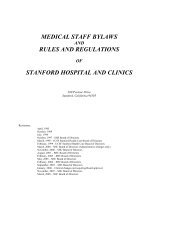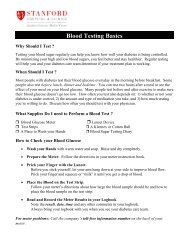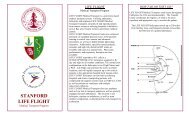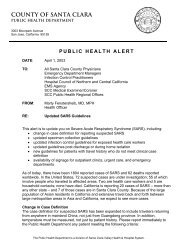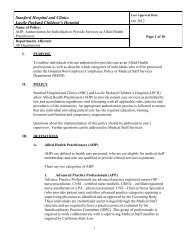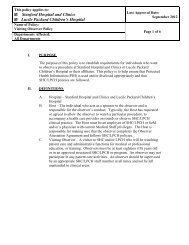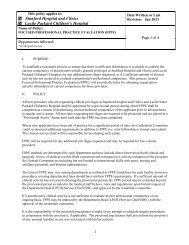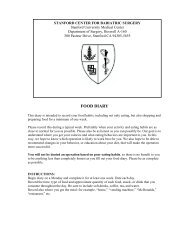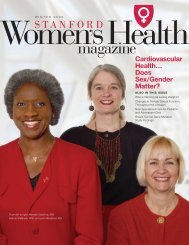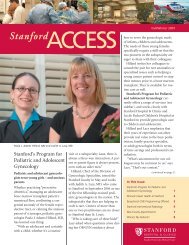rEdEFInIng - Stanford Hospital & Clinics
rEdEFInIng - Stanford Hospital & Clinics
rEdEFInIng - Stanford Hospital & Clinics
You also want an ePaper? Increase the reach of your titles
YUMPU automatically turns print PDFs into web optimized ePapers that Google loves.
CARdIoVASCULAR<br />
CREATINg A PlAN<br />
to<br />
exceed<br />
6<br />
ESSENTIAl FOR lIFE, THE CIRCulATORY<br />
SYSTEM IS A POWERFul NETWORk OF<br />
BlOOD VESSElS THAT DElIVERS OxYgEN<br />
AND NuTRIENTS, FIgHTS INFECTION AND<br />
REMOVES WASTE FROM THE BODY.<br />
expectations<br />
Return to TOC<br />
mEETING ComPLEx CHALLENGES<br />
At <strong>Stanford</strong> <strong>Hospital</strong> & <strong>Clinics</strong>, vascular surgeons receive<br />
the most difficult cases from around the Bay Area because<br />
they have the experience, equipment and expertise to<br />
give people better odds for a positive outcome. Vascular<br />
patients like Eugene benefit significantly from recent<br />
technological breakthroughs, many pioneered at <strong>Stanford</strong>,<br />
including high-speed CT and MRI angiography and 3D image<br />
reconstruction technologies that give surgeons detailed<br />
information about what is happening in the vascular<br />
system. Another <strong>Stanford</strong> strength is minimally invasive,<br />
or endovascular, techniques to repair aortic aneurysms.<br />
These techniques employ a catheter threaded into the body<br />
through a small incision and have reduced the risk of death<br />
during surgical repair by more than 50 percent.<br />
When 60-year-old Eugene lee arrived at his local hospital<br />
after his right leg buckled beneath him, he was given<br />
some disturbing news. “They wanted to amputate my leg,”<br />
says Eugene, recalling the verdict that left him and his wife<br />
shaken. Eugene needed a higher degree of care, so he<br />
was transferred to <strong>Stanford</strong> <strong>Hospital</strong>.<br />
A survey of Eugene’s circulatory system showed <strong>Stanford</strong>’s<br />
vascular specialists that in addition to the aneurysm<br />
threatening his right leg, he also had an aneurysm in his left<br />
leg and blockage in his carotid artery. And Eugene wasn’t<br />
just at risk of losing a limb. Another aneurysm in his abdomen<br />
had swollen his aorta, and it looked ready to rupture. When an<br />
aneurysm ruptures in the aorta, the main vessel routing blood<br />
from the heart to the rest of the body, fatal effects can be just<br />
minutes away.<br />
“Multiple aneurysms are not uncommon,” says Dr. Ronald<br />
Dalman, the <strong>Stanford</strong> vascular surgeon who received<br />
Eugene’s transfer. “When you have four or five problems,<br />
it’s about setting priorities and figuring out the best sequence<br />
of treatment. What you need is a coherent plan.” Repairing<br />
Eugene’s aortic aneurysm became the first priority for<br />
Dr. Dalman and his team. Initial surgery stabilized Eugene’s<br />
abdominal aorta, and subsequent revascularization<br />
procedures restored blood flow to Eugene’s legs and repaired<br />
his carotid artery. Eugene’s leg—and his life—were saved.<br />
“I was lucky,” says Eugene. “I was at the right hospital with<br />
the right doctor.”<br />
“I was lucky. I was at the right<br />
hospital with the right doctor.”<br />
Eugene Lee<br />
Cardiovascular Patient<br />
7




